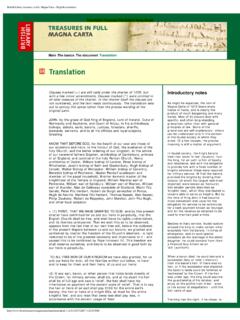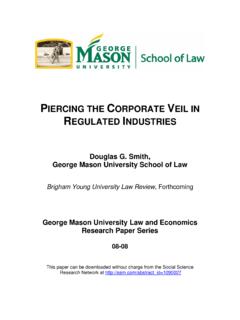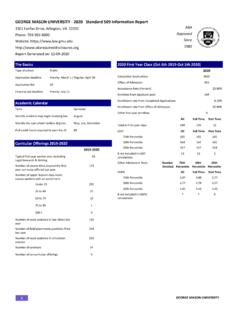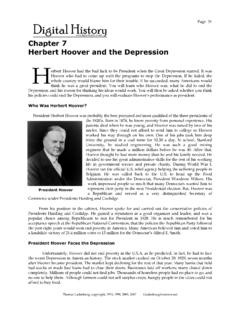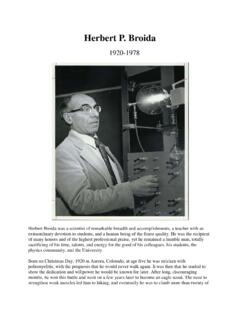Transcription of Excerpt from Herbert L. Packer, Two Models of the Criminal ...
1 1 Excerpt from Herbert L. Packer, Two Models of the Criminal Process, 113 U. Penn. L. Rev. 1 (1964). In this selection, Packer lays out two Models that capture the competing values that inform the laws and institutions of Criminal justice: .. 2. Crime Control Values The value system that underlies the Crime Control model is based on the proposition that the repression of Criminal conduct is by far the most important function to be performed by the Criminal process. The failure of law enforcement to bring Criminal conduct under tight control is viewed as leading to the breakdown of public order and thence to the disappearance of an important condition of human freedom. If the laws go unenforced, which is to say, if it is perceived that there is a high percentage of failure to apprehend and convict in the Criminal process, a general disregard for legal controls tends to develop.
2 The claim ultimately is that the Criminal process is a positive guarantor of social freedom. In order to achieve this high purpose, the Crime Control model requires that primary attention be paid to the efficiency with which the Criminal process operates to screen suspects, determine guilt, and secure appropriate dispositions of persons convicted of crime.. By "efficiency" we mean the system's capacity to apprehend, try, convict, and dispose of a high proportion of Criminal offenders whose offenses become The model , in order to operate successfully, must produce a high rate of apprehension and conviction and must do so in a context where the magnitudes being dealt with are very large, and the resources for dealing with them are very limited. There must then be a premium on speed and finality.
3 Speed, in turn, depends on informality and on uniformity; finality depends on minimizing the occasions for challenge. The process must not be cluttered with ceremonious rituals that do not advance the progress of a case. Facts can be established more quickly through interrogation in a police station than through the formal process of examination and cross-examination in a court; it follows that extrajudicial processes should be preferred to judicial processes, informal to formal operations. Informality is not enough; there must also be uniformity. Routine stereotyped procedures are essential if large numbers are being handled. The model that will operate successfully on these presuppositions must be an administrative, almost a managerial, model . The image that comes to mind is an assembly line or a conveyor belt down which moves an endless stream of cases, never stopping, carrying the cases to workers who stand at fixed stations and who perform on each case as it comes by the same small but essential operation that brings it one step closer to being a finished product, or, to exchange the metaphor for the reality, a closed What is a successful conclusion?
4 One that throws off at an early stage those cases in which it appears unlikely that the person apprehended is an offender and then secures, as expeditiously as possible, the conviction of the rest with a minimum of occasions for challenge, let alone postaudit. By the application of administrative expertness, primarily that of the police and prosecutors, an early determination of probable innocence or guilt emerges. The probably innocent are screened out. The probably guilty are passed quickly through the remaining stages of the process. The key to the operation of the model as to those who are not screened out is what 2 I shall call a presumption of guilt. The concept requires some explanation, since it may appear startling to assert that what appears to be the precise converse of our generally accepted ideology of a presumption of innocence can be an essential element of a model that does correspond in some regards to the real-life operation of the Criminal process.
5 The presumption of guilt allows the Crime Control model to deal efficiently with large numbers. The supposition is that the screening processes operated by police and prosecutors are reliable indicators of probable guilt. Once a man has been investigated with-out being found to be probably innocent, or, to put it differently, once a determination has been made that there is enough evidence of guilt so that he should be held for further action rather than released from the process, then all subsequent activity directed toward him is based on the view that he is probably guilty.. The presumption of guilt is not, of course, a thing. Nor is it even a rule of law in the usual sense. It simply exemplifies a complex of attitudes, a mood. If there is confidence in the reliability of informal administrative factfinding activities that take place in the early stages of the Criminal process, the remaining stages of the process can be relatively perfunctory without any loss in operating efficiency.
6 The presumption of guilt, as it operates in the Crime Control model , is the expression of that confidence. It would be a mistake to think of the presumption of guilt as the opposite of the presumption of The presumption of innocence is not its opposite; it is irrelevant to the presumption of guilt; the two concepts embody different rather than opposite ideas. The difference can perhaps be epitomized by an example. A murderer, for reasons best known to himself, chooses to shoot his victim in plain view of a large number of people. When the police arrive, he hands them his gun and says: "I did it, and I'm glad." His account of what happened is corroborated by several eye-witnesses. He is placed under arrest and led off to jail. Under these circumstances, which may seem extreme but which in fact characterize with rough accuracy the factfinding situation in a large proportion of Criminal cases, it would be plainly absurd to maintain that more probably than not the suspect did not commit the killing.
7 But that is not what the presumption of innocence means. It means that until there has been an adjudication of guilt by an authority legally competent to make such an adjudication, the suspect is to be treated, for reasons that have nothing whatever to do with the probable outcome of the case, as if his guilt is an open question. The presumption of innocence is a direction to officials how they are to proceed, not a prediction of outcome. The presumption of guilt, however, is basically a prediction of outcome.. 3. Due Process Values If the Crime Control model resembles an assembly line, the Due Process model looks very much like an obstacle course. Each of its successive stages is designed to present formidable impediments to carrying the accused any further along in the process.. The Crime Control model .
8 Places heavy reliance on the ability of investigative and prosecutorial officers, acting in an informal setting in which their distinctive skills are given full sway, to elicit and reconstruct a tolerably accurate account of what actually took place in an alleged Criminal event. The Due Process model rejects this premise and substitutes for it a view of informal, nonadjudicative factfinding that stresses the possibility of error: people are notoriously poor observers of disturbing ; confessions and admissions by persons in police custody may be induced by physical or psychological coercion, so that the police end up hearing what the suspect thinks they want to hear rather than the truth; witnesses may be animated by a bias or interest that no one would trouble to discover except one specially charged with protecting the interests of the accused-which the police are not.
9 Considerations of this kind 3 all lead to the rejection of informal factfinding processes as definitive of factual guilt and to the insistence on formal, adjudicative, adversary factfinding processes in which the factual case against the accused is publicly heard by an impartial tribunal and is evaluated only after the accused has had a full opportunity to discredit the case against him. [M]ore is at stake than simply an evaluation of what kinds of factfinding processes, alone or in combination, are likely to produce the most nearly reliable results. The stumbling-block is this: how much reliability is compatible with efficiency? Granted that informal factfinding will make some mistakes that will be remedied if backed up by adjudicative factfinding, the desirability of providing this backup is not affirmed or negated by factual demonstrations or predictions that the increase in reliability will be x percent or x plus n percent.
10 It still remains to ask how much weight is to be given to the competing demands of reliability (a high degree of probability in each case that factual guilt has been accurately determined) and efficiency (a process that deals expeditiously with the large numbers of cases that it ingests). This is only the beginning of the ideological difference between the two Models . The Due Process model could disclaim any attempt to provide enhanced reliability for the factfinding process and still produce a set of institutions and processes that would differ sharply from those posited by the demands of the Crime Control model . Indeed, it may not be too great an oversimplification to assert that in point of historical development the doctrinal pressures that have emanated from the demands of the Due Process model have tended to evolve from an original matrix of concern with the maximization of reliability into something quite different and more far-reaching.
